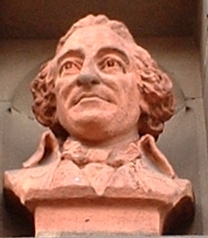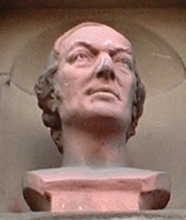The Five BustsThis page includes images of the five busts that decorate the front of Secular Hall, with some explanation of why they were chosen, and other historical details. The busts were commissioned by Josiah Gimson and the sculptor was Ambrose Louis Vago. |
Socrates 470-399 BC
Socrates left no writings, but we know of his teachings through the
works of his pupil Plato, who presented many of his works in the form
of Dialogues in which Socrates was the main speaker, though it is
probable that many of the ideas that are put into his mouth are those
of Plato. Socrates is also mentioned in works of his contemporary
Xenophon. Socrates taught by getting people to say what they thought
and then questioning them and revealing inconsistencies. He proved to
be too successful in getting young men to think for themselves, so that
they started to dispute with their elders. He was charged by the elders
with leading youth astray, and sentenced to die, by drinking hemlock. Skeptic magazine (2008 Jan-June)
features The Death of Socrates
by Jacques-Louis David, and there is a high resolution image on John Toth's Inner Eye site.
Jesus c.4 BC - c.30 AD

It should not be a surprise to find a bust of Jesus on a secular building. Many early members of the Society came from a Christian background, particularly Unitarian, and saw Jesus as an altogether human teacher with nothing supernatural about him.
This view was supported by, amongst other writings, by two books by German theologians: Das Leben Jesu [The Life of Jesus, Critically Examined] (1835) by David Friedrich Strauss and The Essence of Christianity (1841) by Ludwig Feuerbach. These books were translated into English (1846, 1854) by the famous novelist Mary Ann Evans who wrote under the male pen name of George Eliot. She was prominent among the freethinkers of the time, and of course she knew G. J. Holyoake, the founder of Secularism, and like him came from the midlands.
More on Jesus and links to other resources.
Voltaire (1694 - 1778)

The satires of Francois Marie Arouet who wrote under the pen-name of
Voltaire got him jailed and exiled from France to England where he was
in 1727 when Isaac Newton died. He was very impressed that a country
would revere a mere Mathematician so highly as to bury him with great
ceremony in the national mausoleum, Westminster Abbey. He helped to
popularise Newton's ideas, and was a tireless campaigner for justice.
Lucid Cafe on Voltaire
Kirjasto
on Voltaire
Clarence
Darrow on Voltaire
A Treatise on Toleration by Voltaire (1763),
extracts
Thomas Paine 1737 - 1809

Tom Paine was a working man who became involved in organising labour
and trying to negotiate better pay and conditions. As a result he lost
his job and, on the advice of Benjamin Franklin, emigrated to America
in 1774, where his book Common Sense, and other writings
arguing for republican government and independence were influential in
the American revolution of 1776. He returned to England shortly before
the French revolution of 1789 which inspired his very influential book
the Rights of Man.
William Blake the poet warned him to escape
to France before being charged with treason. There he fell foul of
Robespierre and while in jail wrote his anti-religious work the Age
of Reason. For further details see the Paine
Biography.
Robert Owen 1771 - 1858

Owen is known as the father of the co-operative movement. He banned
employment of young children in his factories, provided schooling,
began schemes for old age and sickness insurance, helped found the
first British trade union. In 1839 Owen gave a series of four lectures
in Leicester, supporting the already strong tradition of free thought
in the town. He had used the term ‘Rational Religion’ which his follower
G. J. Holyoake took up under the name of ‘Secularism’. For further
details see the Owen Biography.
Acknowledgements
The images of the busts shown here are taken by permission from the CD-Rom A Walk Round Leicester produced by Max Wade-Matthews and available from the Heart of Albion Press.
Some details of the busts are available on pages belonging to the Public Monument and Sculpture Association.
Page updated 7 February 2015 JRC










